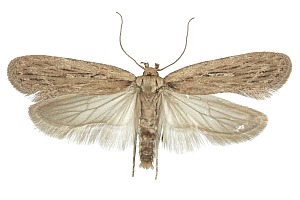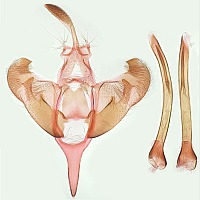

 +6Kontinente:EUASAF
+6Kontinente:EUASAF2. Diagnose
2.1. Männchen
2.2. Genitalien
2.2.1. Männchen
3. Biologie
3.1. Nahrung der Raupe
Noch unbekannt! Da alle anderen Arten der D. veneficella-Gruppe, zu der die Art gehört, soweit bekannt an Doldenblütlern (Apiaceae) leben, vermutet Buchner (2017) stark, dass das auch für D. junnilaineni gilt.
4. Weitere Informationen
4.1. Etymologie (Namenserklärung)
Buchner (2017) begründet die Namenswahl: "The species name, a noun in the genitive case, honours Jari Junnilainen, the Finnish lepidopterologist, who collected the third specimen ever found of D. pentheri, and the only specimen collected in recent time. This specimen was essential to understand D. pentheri and D. junnilaineni sp.n. as distinct species and therefore it was the prerequisite to describe this new species at all."
4.2. Faunistik
Buchner (2017) kennt die Art aus Europa durch Nachweise aus Griechenland (locus typicus ist Epirus, Ammoudia 10 km SE Parga) und Spanien, außerhalb davon von der Türkei, Syrien und Marokko.
4.3. Typenmaterial
Buchner (2017) schreibt zum Holotypus: "♂, Greece, Epirus, Ammoudia 10 km SE Parga, 0m, 39°14,85' N 20°28,90' E, 23.VI.2008, leg. W. Schmitz, ex coll. W. Schmitz, Gp DEEUR 5997 P. Buchner, will be stored in TLMF."
Die lange Serie an Paratypen stammt aus den fünf im Kapitel Faunistik genannten Ländern, die meisten davon aus dem Süden von Spanien.
4.4. Literatur
- Erstbeschreibung: Buchner, P. (2017): Depressaria junnilaineni, a new species from the veneficella species-group (Depressariinae, Lepidoptera) from the West Palaearctic, with additional information on the rare species D. pentheri and D. erzurumella. — Miscellaneous Papers (Centre for Entomological Studies Ankara), 166: 1-20. [Digitalisat auf archive.org]










